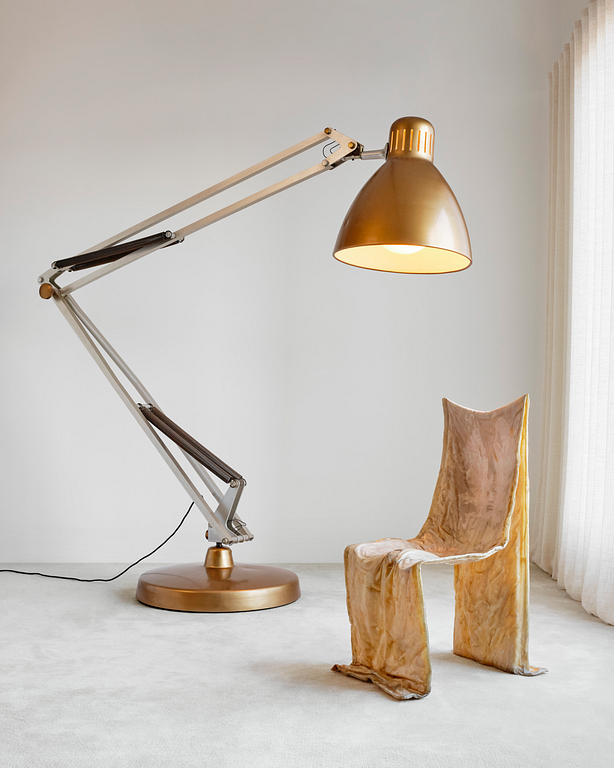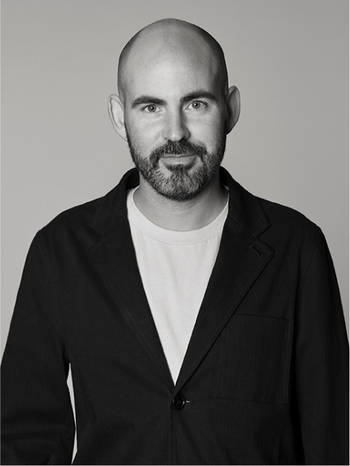Gaetano Pesce
a "Moloch" floor lamp, ed. 009, Bracciodiferro, Italy, ca 1970-71.
Steel and bronze anodised aluminium, internal glass shade, base and springs in steel, wooden detail, maker's mark MOLOCH RIDISEGNO DI GAETANO PESCE PRODUZIONE-BRACCIODIFERRO-PRIMO CENTINAIO ESEMPLARE N.009. Adjustable height ca 220-270 cm, shade diameter ca 65 cm.
Designed in 1970 and executed in an edition of approximately 20 numbered copies, of which the present lamp is number 9.
Scratches, dents, wear.
Provenance
Private Collection, Sweden, since the late 1990s.
Literature
"Domus", no. 525, September 1972, compare p. 38.
Emilio Ambasz (ed.), "Italy: The New Domestic Landscape: Achievements and Problems of Italian Design", Museum of Modern Art 1972, compare p. 97.
Giuliana Gramigna, "Repertorio 1950-1980 Survey Of 30 Years Of Italian Design", Arnoldo Mondadori Editore 1985, compare p. 357.
Charlotte & Peter Fiell, "1000 Lights Vol. 2: 1960 to present", Taschen 2005, compare pp. 130‑131.
Glenn Adamson & Gaetano Pesce, "Gaetano Pesce: The Complete Incoherence", The Monacelli Press 2022, compare pp. 96-97 and 99.
More information
Italian architect and designer Gaetano Pesce's role in the postmodern design movement cannot be overstated. As one of the most influential designers of our time, with a pioneering and innovative approach to design that still lives on today as a great source of inspiration for young designers, Pesce created furniture and objects that crossed borders.
In 1970, the market-leading Italian furniture company Cassina wanted to work with the influential designer but considered that Pesce's designs stood out as far too radical to be marketed under their own name. Therefore, Bracciodiferro is founded - a sister company intended to give Pesce an artistic sanctuary.
The monumental floor lamp Moloch was one of the first products launched by Bracciodiferro between the years 1970-72. Pesce saw the need for a fixture that could fill large halls and public spaces. In the spirit of the Dadaist artist Marcel Duchamp, Pesce chose an already existing product; the Norwegian designer Jac Jacobsen's table lamp "L-1" from 1937 and manufactured by Luxo. By radically enlarging the lamp, it became more than a functional object - an iconic totem and metaphor for commercialization and consumption. Pesce named the floor lamp after the ancient Canaanite god Moloch, who in the Hebrew Bible is associated with the practice of child and animal sacrifice and described as an insatiable monster which Pesce surely wanted to highlight as an antithesis to the prevailing commercialization of society.
Moloch was originally intended to be produced in an edition of one hundred, but it is estimated that between twenty and thirty examples were made before production was discontinued in 1975. The present lamp is number 009 in this edition. A Moloch lamp can be found in the collections of the Museum of Modern Art in New York.
Designer
Gaetano Pesce was an Italian architect and designer who can undoubtedly be considered one of the most influential figures in the postmodern design movement. Through his groundbreaking approach and irresistible desire to break away from the strict ideals of modernism, Pesce shaped a new direction in design and architecture, where individuality and human emotion took centre stage. Pesce’s legacy lives on, not only through his groundbreaking works but also through the significant impact he has had on generations of young designers, who continue to be inspired by his courage to challenge norms and push the boundaries of what design can be.
Read more







































































































